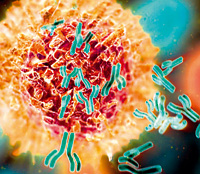Obinutuzumab Tops Rituximab in CLL Trial
In a front-line trial of older patients with newly diagnosed chronic lymphocytic leukemia, obinutuzumab topped rituximab, demonstrating improvements in response rate and progression-free survival, according to results presented at the ASH annual meeting.
Rituximab binds specifically to CD20, found on developing and mature B cells, but not on stem cells or plasma cells; source: Roche

Obinutuzumab topped rituximab in a large chronic lymphocytic leukemia (CLL) trial of older, newly diagnosed patients, demonstrating improvements in response rate and progression-free survival (PFS), according to results presented at the 2013 American Society of Hematology (ASH) Annual Meeting and Exposition.
Results of the phase III CLL11 trial found that as a front-line therapy, the anti-CD20 monoclonal antibody obinutuzumab (GA101) combined with chlorambucil was more efficacious than rituximab combined with chlorambucil.
Patients who received obinutuzumab had a median PFS of 26.7 months compared with 15.2 months for patients receiving rituximab (hazard ratio [HR] = 0.39, P < .001). Patients were followed up for a median of 19 months.
“This clearly tells us that obinutuzumab is superior to rituximab with regard to PFS,” said Valentin Goede, MD, of the Center of Integrated Oncology Cologne-Bonn at the University Hospital Cologne in Germany, during a press briefing. Dr. Goede presented the results at the plenary session of the 2013 ASH annual meeting.
Overall response rates were also higher in the obinutuzumab arm (78% vs 65%; P < .0001). Twenty-one percent of patients who received obinutuzumab had a complete response compared with 7% of patients who received rituximab.
Follow-up of patients in the trial is still ongoing.
“In my opinion, today we can say that obinutuzumab will replace rituximab in the treatment of elderly CLL patients when combined with a weaker chemotherapy backbone,” said Dr. Goede during a press briefing.
Whether obinutuzumab could also replace rituximab in treating younger, healthier patients who receive rituximab with a more aggressive chemotherapy regimen is not clear. “It is more difficult to provide an estimation for younger patients, where rituximab is combined with much more aggressive backbones which are very effective,” said Goede, emphasizing that obinutuzumab has not been studied in this context.
The trial randomized 781 patients into three treatment arms-chlorambucil alone (118 patients), chlorambucil plus rituximab (330 patients), or chlorambucil plus obinutuzumab (333 patients). The primary endpoint of the trial was PFS.
Chlorambucil was administered at 0.5 mg/kg on days 1 and 15, and then every 28 days for 6 cycles. Obinutuzumab was administered at 100 mg as an IV dose on day 1, 900 mg on day 2, and 1000 mg on days 8 and 15 in cycle 1, followed by 1000 mg on day 1 of cycles 2 through 6. Rituximab was given as a 375 mg/m2 IV dose on day 1 of cycle 1, and 500 mg/m2 IV dose on day 1 of cycles 2 through 6.
Initial analysis of this trial showed that adding either rituximab or obinutuzumab resulted in better efficacy compared with chemotherapy alone.
Rituximab, in combination with chemotherapy, is the most common treatment for CLL, yet the anti-CD20 agent is not as effective in treating CLL as it is in other hematologic cancers. The combination is also not well tolerated by elderly patients.
At the end of treatment, the number of patients in the obinutuzumab arm who had minimal residual disease in the blood was more than tenfold lower than those patients in the rituximab arm (3.3% compared with 37.7%, respectively). Minimal residual disease in the bone marrow was also lower in patients treated with obinutuzumab compared with those treated with rituximab.
Longer-term follow-up of the comparison of each combination therapy arm to chemotherapy alone was also presented. The median follow-up was 23 months. Both obinutuzumab or rituximab, when combined with chemotherapy, improved PFS compared with chemotherapy alone (HR = 0.18, P < .001, for obinutuzumab vs chemotherapy; HR = 0.44, P < .0001, for rituximab vs chemotherapy).
Median PFS for the chemotherapy-alone arm was 11.1 months.
An overall survival benefit was seen with obinutuzumab compared with chemotherapy alone (HR = 0.41, P = .0022). Overall survival was not statistically significant different for rituximab compared with chemotherapy alone (HR = 0.66, P = .113). The median overall survival in the trial has not yet been reached.
The frequency of grade 3 adverse events was higher in patients treated with obinutuzumab compared with rituximab (70% compared with 55%). Grade 3 neutropenia and thrombocytopenia were slightly higher in the obinutuzumab treatment arm. Patients treated with obinutuzumab had a higher frequency of infusion-related reactions (20% vs 5%) that was limited to the first infusion.
“Prior to CLL11, there was skepticism that another anti-CD20 antibody would beat rituximab so definitively in a head-to-head study. The CLL11 data are very impressive,” said Jennifer R Brown, MD, PhD, a specialist in lymphoma and CLL and an assistant professor of medicine at the Dana-Farber Cancer Institute in Boston, who was not involved in the study. “It will be of great interest to study obinutuzumab in other contexts to see if it can add efficacy for other patient populations.”
The results of this trial shows that frail CLL patients now have a new treatment option, said Philip McCarthy, MD, director of the blood and marrow transplant program at Roswell Park Cancer Institute in Buffalo, New York, who was not involved with the study. “The antibody generates more CLL killing,” said McCarthy. “Obinutuzumab relies less on complement-mediated cytotoxicity, so it appears to be more effective than rituximab due to modifications that allow these mechanisms of killing to be favored.”
Obinutuzumab (Gazyva) is marketed by Roche and was approved in November for previously untreated CLL patients based on the results of the CLL11 study.